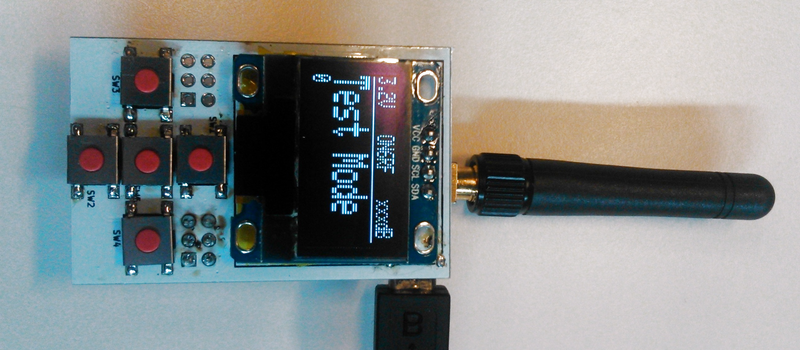The Internet of Things has been presented as the future of consumer electronics for the better part of a decade now. Billions have been invested, despite no one actually knowing what the Internet of Things will do. Those billions need to go somewhere, and in the case of Texas Instruments, it’s gone straight into the next generation of microcontrollers with integrated sub-GHz radios. [M.daSilva]’s entry to the 2016 Hackaday Prize turns these small, cheap, radios into a portable communicator.
This ‘modem for the 400 MHz band’ consists simply of an ATmega microcontroller, TI’s CC1101 sub-GHz transceiver, an OLED display, and a UHF power amplifier. As far as radios radios go, this is as bare bones as it gets, but with the addition of a USB to serial chip and a small program this radio can send messages to anyone or anything in range. It’s a DIY pager with a couple chips and some firmware, and already the system works.
[M.daSilva] has two use cases in mind for this device. The first is an amateur radio paging system, where a base station with a big power amp transmits messages to many small modules. The second use is a flexible mdoule that links PCs together, using Ham radio’s data modes. With so many possibilities, this is one of the best radio builds we’ve seen in this year’s Hackaday Prize.





















Great sounding. and your soldering not that bad.
I am not into radios that much, but what would the rang of something like this be?
Love the concept.
This is using an off-the-shelf PCB for doing all the RF… there is not a PA or anything yet. The default output of the CC1101 is +12 dBm, so I would think a range of about a few hundred feet would be practical.
Cool. at 400Mhz, I’d expect it to punch through lead-lined walls, almost?
Why would you expect that? Higher frequency does mean shorter wavelength so the signal can fit through smaller openings such as windows. It has nothing to do with ‘punching through’ anything. Are you confusing frequency with power level? They are unrelated.
By your logic X-rays wouldn’t work. Of course lower frequencies travel through objects better, it’s a large component of path loss. Don’t think it’d work well through a lead wall all the same but it’d pass through walls much better than Wi-Fi.
Does your modem transmit control signals with that data?
If not maybe it’ll be ok in the EU at 433MHz, but not here in the states for anything other than prototypes.
I’m not aware of any special exception in the rules for prototypes. Well.. other than just that you probably will not get caught.
The FCC does allow you to transmit in the 433 MHz bad with a computing device, but that allowance uses a different set of roles than for remote control devices such as garage door openers or automotive key fobs.
http://www.edn.com/electronics-blogs/eye-on-iot-/4437311/Using-433-MHz-for-wireless-connectivity-in-the-Internet-of-Things
— excerpt:
First, 15.231.a.3 prohibits scheduled periodic data transmissions, but it does allow polling transmissions (with data) that cannot exceed two seconds of transmission time per hour. Second, 15.231.e makes a provision for more frequent periodic polling transmissions as long as “the duration of each transmission shall not be greater than one second and the silent period between transmissions shall be at least 30 times the duration of the transmission but in no case less than 10 seconds.” Although this ruling contemplates a maximum of one second of transmission time, it really says that if you want to transmit at the maximum repetition rate, you can only transmit for 300mSec every 10 seconds. This restriction to one transmission in 10 seconds is the important thing to glean here.
s/roles/rules/
Hams have a different set of rules that allow higher power and longer transmission. In Canada I’m legally allowed to transmit hundreds of watts using a 12MHz bandwidth on the 70cm band although I rarely use more than a couple watts.
http://www.ic.gc.ca/eic/site/smt-gst.nsf/eng/sf01226.html#p10.2
http://www.arrl.org/part-97-text
Isn’t this what the Moteino is already doing?
Oplink (Open Pilot Link) already does this. Is basically a serial line over 433Mhz used for open pilot telemetry.